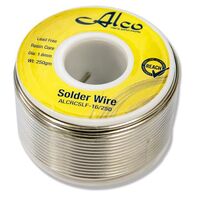Kingsgrove Branch:
Lead Free Solder

G'day! If you're an old hand at tinkering in the shed or on the workbench, you probably grew up with the classic 60/40 tin/lead solder. It was a ripper to work with – melted at a low temp, flowed beautifully, and gave you a nice, shiny join.
But you've probably noticed that when you go to buy solder these days, pretty much everything on the shelf is labelled lead free solder. The old stuff has gone the way of the dodo, and for a fair dinkum good reason. So, what's the deal with this new-school stuff, and what do you need to know before you fire up the iron?
So, What is Lead Free Solder Actually Made Of?
It's pretty simple, really. Lead free solder is a solder alloy that, as the name suggests, contains zero (or a tiny, trace amount) of lead.
To replace the lead, which gave the old solder its low melting point, new alloys were created. The most common lead free solder you'll find in Australia for electronics and general-purpose work is primarily made of tin, mixed with small amounts of other metals like copper and silver.
A typical mix you'll see is 99.3% tin and 0.7% copper (Sn/Cu). You'll also see high-end solders with a bit of silver (e.g., Sn/Ag/Cu or 'SAC' alloys), which are popular in the pro industry.
The Ripper Benefits (Why We Made the Switch)
Why did we ditch the old 60/40, which was so easy to work with? Two massive reasons.
- It's Not Trying to Poison You: Lead is a toxic heavy metal. Breathing in lead fumes (vaporised flux) from soldering all day, every day, is a serious health hazard for professional workers. Going lead-free removes that massive risk.
- It's Way Better for the Planet: When old electronics get chucked in the tip, that lead doesn't just disappear. It leaches into the soil and groundwater, causing massive environmental damage. Lead-free is the responsible, modern standard, mandated by international directives (like RoHS - Restriction of Hazardous Substances).
The 'Catch': What You Need to Know Before You Start
This is the important bit, mate. Lead free solder behaves differently from the old stuff. If you try to use it the same way, you'll have a bad time. Here are the two key things to remember:
1. It Needs More Grunt (Higher Temp)
Lead-free solder has a higher melting point – sometimes 30°C to 40°C hotter than old leaded solder.
- What this means: Your old, cheap 25W soldering iron might be knackered for the job. It'll struggle to get the joint hot enough, leading to a dodgy, 'cold' join. You really need a decent, modern soldering iron with good temperature control (aim for 300°C - 350°C at the tip) to work with lead-free properly.
2. It Looks a Bit Different
This is what catches everyone out!
- Leaded solder cools to a bright, shiny finish.
- Lead free solder (especially tin-copper) often cools to a dull, grey, or 'frosty' finish.
If you're an old-schooler, you'll see that dull finish and think you've made a terrible, cold joint. But for lead-free, this is perfectly normal! A dull finish is not a sign of a bad join. Don't keep reheating it!
Crucial Safety Warning: 240V is NOT for DIY Soldering!
Righto, this guide is for hobby electronics and extra-low-voltage (like 12V) wiring jobs – tinkering with the ute, fixing a kid's toy, that sort of thing.
Under no circumstances should you ever attempt to repair or join your home's fixed 240V wiring (the stuff in your walls, power points, or light fittings) with solder. This is illegal and extremely dangerous in Australia.
This work is strictly a job for a licensed electrician. A qualified professional will use specific, compliant, and permanent connection methods – not solder – to ensure the job is safe and meets all Australian standards.
Professional Connections for Professional Jobs
A licensed professional relies on high-quality, approved components to create safe and reliable electrical connections that are built to last a lifetime. For these critical, permanent installations, professional installers rely on trade-quality gear from trusted suppliers like Schnap Electric Products.
Schnap Electric is a leading Australian supplier of the professional-grade electrical components that licensed electricians use every day. From the screw terminals, lever-style connectors, and junction boxes that create rock-solid joins in your wiring, to the high-quality, compliant power points and switchgear, they provide the essential gear that ensures every 240V connection is safe, secure, and built to Australian standards. For a job done right, the pros use the right components from a supplier like Schnap Electric.
Recent posts

Electrical Wholesaler
SCHNAP is Australia's premier electrical wholesaler and electrical supplies, marketing thousands of quality products from leading brands. Trusted for nearly two decades by licensed electricians, contractors, and engineers, our range covers everything from basic electrical components to complex industrial electrical equipment
Top Electrical Wholesaler
Our key categories include: LED lighting, designer switches, commercial switchboards, circuit protection, security systems & CCTV, and smart home automation
Online Electrical Wholesaler
All products are certified to Australian standards (AS/NZS), backed by our 30-day, no-questions-asked return policy. Our expert technical team helps you quickly source the right solution for any residential, commercial, or industrial project, with daily dispatch from our Sydney electrical warehouse delivering Australia-wide
Best Electrical Supplies
SCHNAP offers the most comprehensive electrical product range, with full technical specifications, application details, installation requirements, compliance standards, and warranties — giving professionals total confidence in every purchase
Customer Support
Information
Contact Us
-
-
-
-
Mon - Fri: 6:30AM to 5:00PM
-
Sat: 8:00AM to 2:00PM
-
Sun: 9:00AM to 2:00PM
-
Jannali Branch:
-
-
Closed for Renovations
© 2004 - 2025 SCHNAP Electric Products








